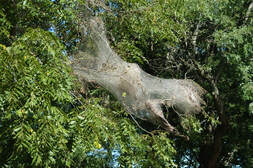
Mature caterpillars are yellowish with black and brown markings, and have many tufts of long hair. As larvae mature, they crawl down the tree and spend the winter as pupa in the leaf litter under the tree. High populations of fall webworm can completely defoliate host plants but do not cause significant harm this late in the season. We normally consider fall webworm damage to be purely aesthetic, and control is not needed to protect the health of the tree.
Control Next Year
There are methods to control this insect earlier in the season. Pruning and destroying the infested portions of branches is a common control practice while webs are still small. Also, a stick or pole with a nail inserted crosswise can be used to snag individual webs. Twisting the pole after insertion will cause the web to wrap around the pole where it can be removed and destroyed. Instead of a nail inserted crosswise, some people use a toilet brush attached to the end of a pole.
Insecticides can also be used for control but a high-pressure sprayer is needed to penetrate the webs. Numerous products can be used for control including spinosad (Conserve; Natural Guard Spinosad; Captain Jack’s Dead Bug Brew; Monterey Garden Insect Spray), cyfluthrin (Tempo, BioAdvanced Vegetable & Garden Insect Spray) and permethrin which is found in the following products.
38 Plus Turf, Termite & Ornamental Insect Spray - Hi-Yield
Eight Vegetable, Fruit & Flower Conc. - Bonide
Eight Yard & Garden RTS - Bonide
Lawn, Garden, Pet, & Livestock Insect Spray - Hi-Yield
Again, control is not necessary to protect the health of the tree this late in the season. (Ward Upham)
 RSS Feed
RSS Feed
